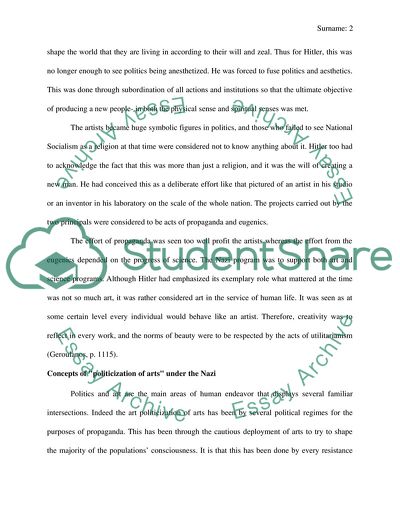Cite this document
(How Nazis Use the Concepts of Politicization of Arts and Aestheticization of Politics Article Example | Topics and Well Written Essays - 3750 words, n.d.)
How Nazis Use the Concepts of Politicization of Arts and Aestheticization of Politics Article Example | Topics and Well Written Essays - 3750 words. https://studentshare.org/history/1831387-how-did-the-nazis-use-the-concepts-of-politicization-of-arts-and-aestheticization-of-politics-to-gain-support-from-the-german-people
How Nazis Use the Concepts of Politicization of Arts and Aestheticization of Politics Article Example | Topics and Well Written Essays - 3750 words. https://studentshare.org/history/1831387-how-did-the-nazis-use-the-concepts-of-politicization-of-arts-and-aestheticization-of-politics-to-gain-support-from-the-german-people
(How Nazis Use the Concepts of Politicization of Arts and Aestheticization of Politics Article Example | Topics and Well Written Essays - 3750 Words)
How Nazis Use the Concepts of Politicization of Arts and Aestheticization of Politics Article Example | Topics and Well Written Essays - 3750 Words. https://studentshare.org/history/1831387-how-did-the-nazis-use-the-concepts-of-politicization-of-arts-and-aestheticization-of-politics-to-gain-support-from-the-german-people.
How Nazis Use the Concepts of Politicization of Arts and Aestheticization of Politics Article Example | Topics and Well Written Essays - 3750 Words. https://studentshare.org/history/1831387-how-did-the-nazis-use-the-concepts-of-politicization-of-arts-and-aestheticization-of-politics-to-gain-support-from-the-german-people.
“How Nazis Use the Concepts of Politicization of Arts and Aestheticization of Politics Article Example | Topics and Well Written Essays - 3750 Words”. https://studentshare.org/history/1831387-how-did-the-nazis-use-the-concepts-of-politicization-of-arts-and-aestheticization-of-politics-to-gain-support-from-the-german-people.


